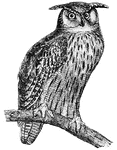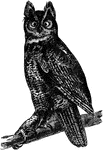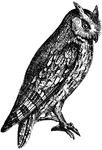Clipart tagged: ‘Bubo virginianus’

Great Horned Owl
Horned owls are distinguished by two tufts or horns of feathers placed on each side of their head.

Great Horned Owl
"Bubo virginianus. Great Horned Owl. Hoot Owl. Cat Owl. Distinguished by its large size and conspicuous…

Scops-Eared Owl
The scops-eared owl is diminutive in size, not exceeding that of the thrush, (Figuier, 1869).

Scops-Eared Owl
The scops-eared owl is diminutive in size, not exceeding that of the thrush, (Figuier, 1869).